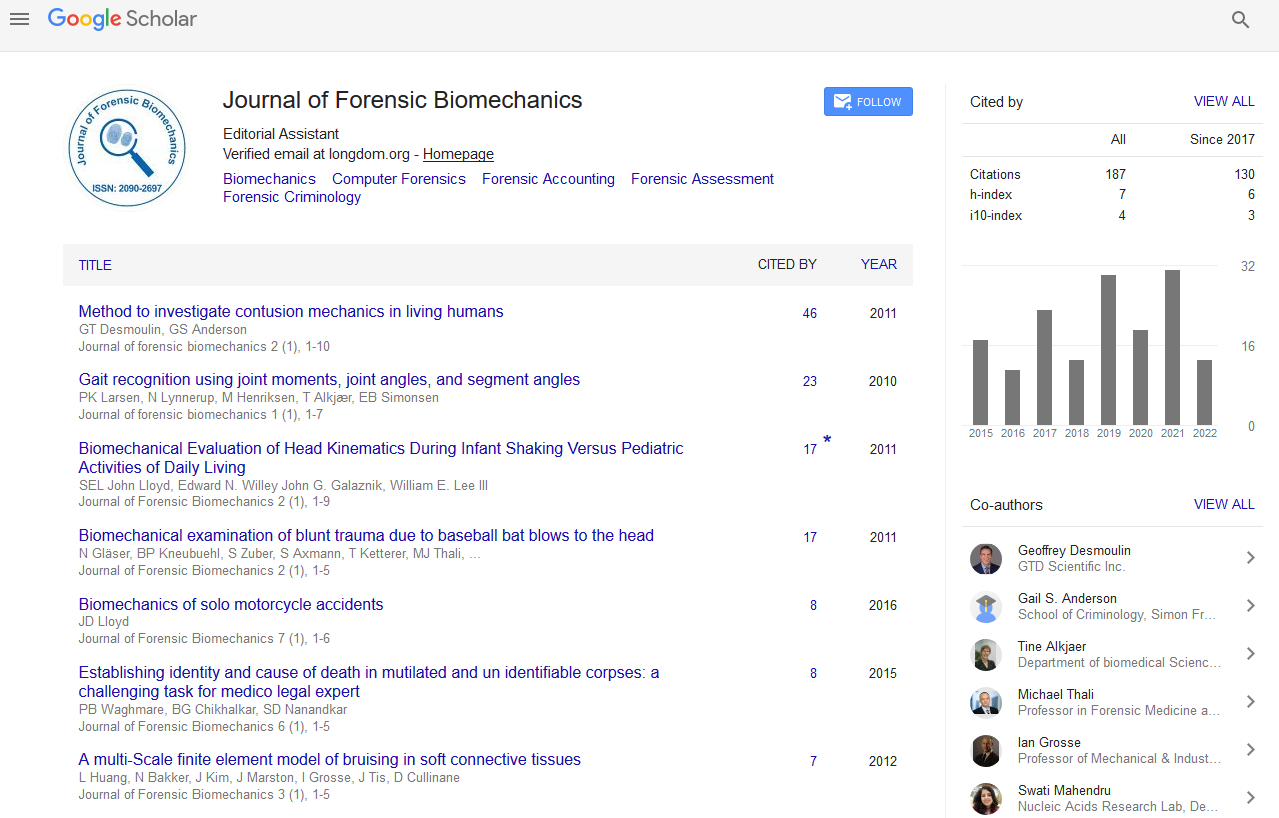Indexed In
- Genamics JournalSeek
- SafetyLit
- Ulrich's Periodicals Directory
- RefSeek
- Hamdard University
- EBSCO A-Z
- Geneva Foundation for Medical Education and Research
- Euro Pub
- Google Scholar
Useful Links
Share This Page
Journal Flyer

Open Access Journals
- Agri and Aquaculture
- Biochemistry
- Bioinformatics & Systems Biology
- Business & Management
- Chemistry
- Clinical Sciences
- Engineering
- Food & Nutrition
- General Science
- Genetics & Molecular Biology
- Immunology & Microbiology
- Medical Sciences
- Neuroscience & Psychology
- Nursing & Health Care
- Pharmaceutical Sciences
Research Article - (2023) Volume 14, Issue 2
Startle Response and Firearm Draw Performance in Law Enforcement Officers during a Lethal Force Simulated Domestic Assault
Michael A Kantor1*, Dane E. Bartz2, William J. Lewinski3 and Robert W. Pettitt42School of Nursing and Health Sciences, Saint Xavier University, Chicago, Illinois, United States of America
3Division of Research, Force Science® LTD., Mankato, Minnesota, United States of America
4Department of Health Sciences, Salt Lake Community College, West Jordan, Utah, United States of America
Received: 27-Mar-2023, Manuscript No. JFB-23-20419; Editor assigned: 30-Mar-2023, Pre QC No. JFB-23-20419 (PQ); Reviewed: 13-Apr-2023, QC No. JFB-23-20419; Revised: 20-Apr-2023, Manuscript No. JFB-23-20419 (R); Published: 28-Apr-2023, DOI: 10.35248/2090-2697.23.14.430
Abstract
In situations where Law Enforcement Officers (LEOs) must deploy their weapon, their ability to react and respond quickly is crucial. Prior research suggested that the controlled and predictable environments for training LEOs alter performance during a dynamic scenario. The present study evaluated the Startle Response (SR) and Firearm Draw Performance (FDP) of LEOs in response to a simulated unanticipated threat of lethal force with a firearm during a simulated domestic assault call. Twenty-two active duty LEOs (Age=34 ± 7 years; Body Mass=92 ± 12 kg; Height=181 ± 9 cm) engaged in a training scenario of a home visit as a follow up to a domestic violence call. An experimental trial resulted in a firearm ambush from distance of 6 m in the simulated home. LEOs were video-recorded and joint kinematics was measured using wearable sensors. A control trial was performed under no duress that was measured to provide a comparison of FDP. The average SR time was 0.78 s ± 0.44 s; the most common SR was neck flexion. FDP between conditions was significantly different (z=2.87, p<0.01) with the experimental trial 0.35 s ± 0.50 s slower. Initiation of the firearm draw occurred -0.19 s ± 0.51 s before the complete execution of the SR movement. Consistent exposure to dynamic training scenarios may improve FDP during lethal threats. The SR was observed in majority of LEOs following an unanticipated lethal threat stimulus therefore delaying the response to a threat and requiring a reframing of traditional reaction response paradigms.
Keywords
Ambush; Domestic; Disturbance call shooting performance; Shooting time; Reflex
Introduction
Law Enforcement Officers (LEOs) receive firearms and defensive tactics training during the academy and periodically during active duty to comply with state and departmental standards. LEOs practice motor skills such as firearm draw to marginalize wasted movement. In the unfortunate situation where LEOs need to deploy their service weapon, their ability to draw rapidly will be reflected by their training history and frequency of practice [1]. Effective handgun drawing is a rehearsed motor pattern; however, successfully adjusting the motor pattern in a dynamic environment is essential. A firearm draw can be learned in different environments, such as control on the shooting range or in immersed training drills with unknown dynamic stimuli. These different environments represent the different environments where individuals can learn skills: Closed and open skill environments, respectively [2].
The examination of Firearm Draw Performance (FDP) in controlled laboratory settings with no stimulus has ranged from 1.5 s to 1.8 s ± 0.46 s [3,4]. Responding to warning and non-threatening visual stimuli resulted in a total Movement Time (MT), including Reaction Time (RT) of 1.90 s ± 0.30 s to 1.94 s ± 0.30 s for a hip holster and thigh holster respectively, using a Glock 22P with an undisclosed holster type [5]. Examination of FDP when facing an unanticipated stimulus of deadly force has been examined previously. In a recent study involving the unanticipated simulated threat of lethal force in a traffic stop scenario, many subjects exhibited a “Startle Response” (SR) [6]. The authors noted that the typical SR was the LEOs blocking themselves with a hand and arm while backpedaling to draw their firearm. The SR is an intense, fast reaction to an unexpected stimulus. However, alternative definitions describe SR as a total-body response to an auditory, visual, vestibular, or esthetic stimuli specifically, the sound of a pistol shot evoking a shoulder shrug flinch [7-10]. Given the clear presence of an SR in a traffic stop study to the unanticipated stimuli, of a handgun and the sound of the gunshot, an examination of the presence of an SR under different circumstances might provide further helpful information. Also, given how much LEO FDP varies in controlled settings, examining FDP in response to a lethal threat is crucial to demonstrate and inform us as to how LEOs may perform in the field. The intent is to eventually understand enough about SR to build a training program to provide a way to incorporate an SR into an effective response in a time compressed, critical incident.
The RT paradigm is an overview of the events that make up how the human body initiates a movement or reaction in response to an unanticipated stimulus in a controlled setting, such as a laboratory (Figure 1) [2]. In many situations where an LEO would have to use their weapon, often no warning or foreperiod is provided, unlike in laboratory experiences where a flashing light or a training officer might cue a start. Typically, cues would be related to lethal threat awareness by observing a or experiencing a potential uncontrolled, impending, threat or a surprise ambush attack.
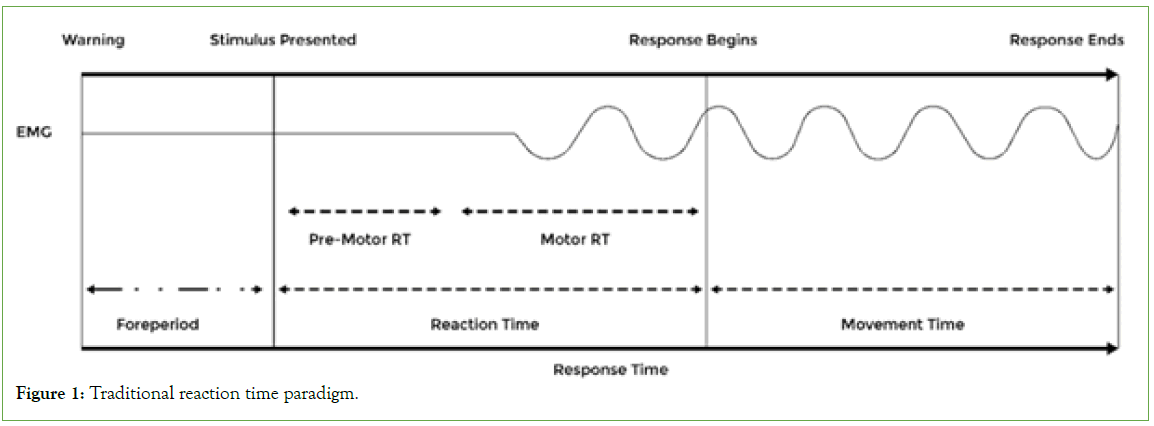
Figure 1: Traditional reaction time paradigm.
Currently, there is no empirical evidence related to the performance of LEO’s FDP and SR in response to a lethal threat during a home visit where an officer is suddenly and unexpectedly attacked(6). The only previous study involving SR in law enforcement involved a traffic stop and did not measure the duration of the SR. Understanding SR duration may expand our understanding of the physical elements that may affect how fast an LEO can effectively respond to a threat. In addition, attacks during traffic stops represent close contacts with an assailant, whereas LEO FDP and SR may differ during an attack occurring further away. Finally, the evaluation of SR and FDP duration has not been simultaneously measured during a single lethal force scenario. Therefore, the purpose of the present study was to evaluate the SR and FDP of active duty LEOs in response to the unanticipated simulated trial of a lethal force threat. The first research question was how does FDP differ between the control and lethal force trial? The first hypothesis was that the FDP would differ between the control and lethal force trials. The second research question was, do years of police experience effect FDP? The exploratory aim was to examine a correlation between the years of police experience and FDP.
Materials and Methods
Experimental overview
The study examined the SR and FDP of LEOs from a modified level 1 holster while in a controlled trial and when faced with a simulated and unanticipated threat of lethal force during a domestic home visit call. Video and kinematic measurements were taken using a camera and wearable motion analysis technology.
Subjects
Using Intellectus Statistical Software, power analysis for a two-tailed paired-samples t-test indicated a minimum sample size to yield a statistical power of at least 0.8 with an alpha of 0.05 and a large effect size (d=0.8) was 15. A total of 22 male LEOs (Age=35 y ± 8 y; Body Mass=94.2 kg ± 13.4 kg; Height=182.0 cm ± 8.9 cm; BMI 28.4 ± 3.4; Years of Police Experience: 10.3 y ± 7.2 y) were included for data analysis. Which achieved statistical power for comparing the FDP in the different conditions. All subjects were from a local police department in Utah, USA. The Chief of the Police Department disclosed investing around $1000 annually per LEO in firearm training. The inclusion criterion was that subjects were currently an active-duty LEO. The exclusion criterion was currently diagnosed with a cardiovascular disease. Before data collection, all subjects provided informed consent, and all procedures were pre- approved by the Rocky Mountain University of Health Professions Institutional Review Board (Protocol#190861-02).
Procedures
Upon arrival, the LEOs wore their uniforms, safety glasses, and had their service weapon replaced with a Glock G17T Standard Training Ammunition practice pistol (GLOCK, Inc; Smyrna, Georgia, USA) with blank training ammunition (Force-on-Force Speer LE: St. Petersburg, FL, USA) with no other weapons on their person. All subjects used a modified level 1 active automatic locking system holster 6390 (Safari Land: Jacksonville, FL, USA). A classroom inside the Police Department’s was arranged to simulate the dining area of a house (Figure 2). The subjects were responding to a domestic violence case involving a female spouse and male spouse and were instructed to provide a report following an interview with the female spouse. The LEO was informed that the entire training exercise would take 60 min of their time.
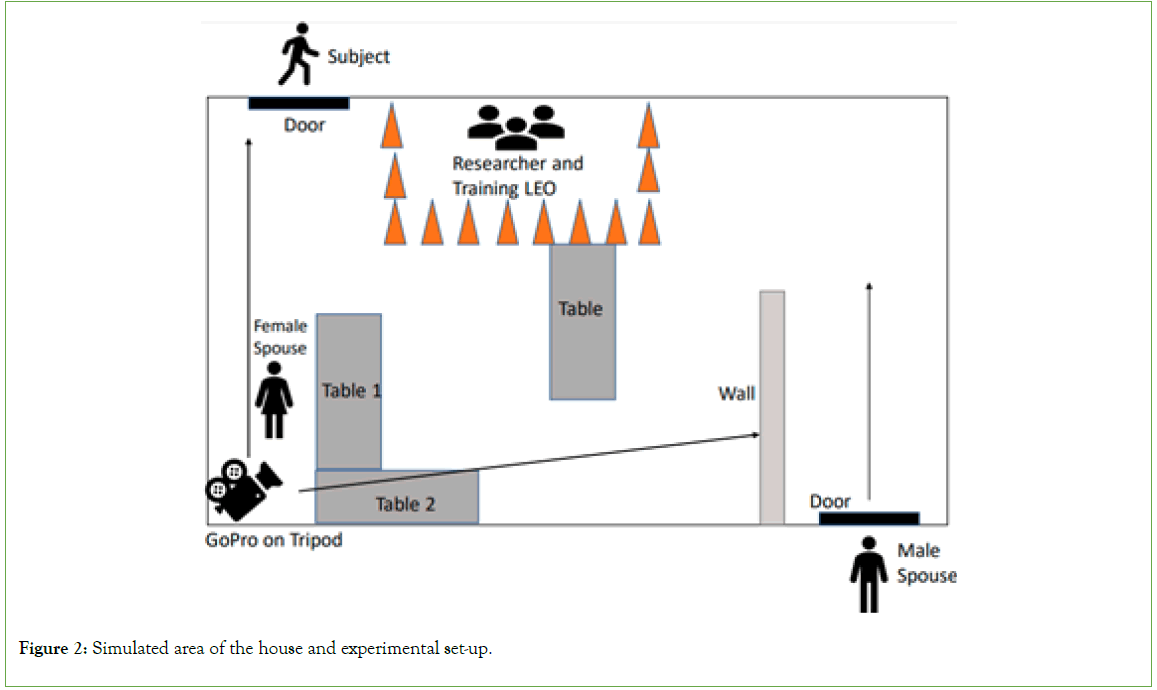
Figure 2: Simulated area of the house and experimental set-up.
Scenario overview
The LEO began outside of the simulated area and was instructed by a researcher to take a report from a woman who had called and complained that her male spouse had hit her and left the property. The LEO was informed that individuals in the room wearing yellow vests are not involved in the scenario but are observing the interview and will blow a whistle to indicate that the trial is over. The LEO was directed toward the simulated house’s entry door within the Police Department. In each trial, the female spouse answered the door and invited the LEO into the room. She walked toward table two, and offered to turn the music off which was being played by a small radio. The LEO began interviewing the female spouse regarding her male spouse’s alleged physical abuse. The first trial lasted 60 s, and one of the researchers wearing a yellow vest within the room blew a whistle to indicate the trial was complete. The LEO was instructed and escorted out of the room and returned to the researcher down the hall to receive further instructions. The researcher instructed the LEO to execute another interview with the female spouse with the exact same scenario. During the second trial, after 20 s-30 s in to the interview with the female spouse, the male spouse, armed with a handgun and training ammunition, entered the room’s rear door, slammed the door, and started yelling from behind the wall toward the female spouse and LEO. After, 10 s-15 s of yelling the male spouse came in view of the LEO from across the room, at a distance of 6 Meters (m). For each assault, the male spouse had his left hand on his forehead, and his right arm concealing the handgun behind his body then without warning he started firing the weapon towards the LEO. The trial ended when the researcher blew a whistle after observing the LEO had returned fire with the two bullets in the gun provided. Similar to the first trial, the training officer and researcher escorted the subject out of the room. The training officer debriefed the LEO and then instructed the LEO to perform a stationary firearm draw at a target 6 m away in an open garage down the hall from the scenario. The purpose of the control trial was to obtain FDP without trial stress to compare it to their performance in the scenario.
Instrumentation
A tripod-mounted camera (GoPro Hero 7, San Mateo, CA, USA) recording at 24 Hz was directed to view the interview between the female spouse and LEO and the end of the wall where the male spouse walked out from across the room. Videos were viewed in a compatible application (GoPro Quik: Version 11.1, San Mateo, CA, USA) on a portable tablet (Galaxy: Tab A, Model number: SM- T510, Suwon-si, South Korea) and was used to view the scenario, and determine what type of SR that occurred.
Kinematic data were collected using a 15-sensor, wearable motion capture system (ADPM Wearable Technologies, Portland, OR, USA), sampling at 128 Hz. The sensors were strapped to each subject according to the manufacturer’s guidelines. All sensors were assigned to all available locations to cover the entire body using the hardware configuration setup in the software (Moveo Explorer, ADPM Wearable Technologies, and Portland, OR, USA). Once the configuration was applied, the sensors were placed on the subject after selecting the protocol. For the foot, sensors were placed centered on the ventral aspect of the foot. The lower leg sensors were placed medial aspect of the tibia at the widest portion of the triceps surae muscle group. In the upper leg (femur), sensors were placed on the lateral aspect of the thigh, approximately 4 cm proximal to the lateral condyle. The lumbar sensor was centered on the low back at the base of the spine. The sternum sensor was placed just superior to the manubrium. The head sensor was placed centered on the front of the forehead. The upper arm sensor was centered over the deltoid tubercle. The wrist sensors were placed dorsal aspect of wrist and worn like a wrist-watch. The hand sensor was placed on the dorsum of the metacarpals of the hand. The APDM sensors have been reported to demonstrate excel- lent reliability (ICC=0.905-0.991) of the inertial sensor system and moderate to high correlations for stride length, mean velocity, and cadence (r=0.551-0.875) indicating that these sensors are acceptable methods to examine joint kinematics [11].
Each subject’s ID was used instead of their name, and self-reported age, height, and weight were reported. Before the start of any trial, the subjects were instructed to stand in the calibration pose after the sensors were placed, which was standing straight up, hand by their side, feet shoulder-width apart, and head facing straight ahead to allow the sensors to calibrate. The protocol that was used during the experimental trial was “Walk.” The “Walk” protocol includes outcome measures related to gait, turning, and joint-angle relative to time after the completion of the trial. During the experimental trial, gait and turning outcomes were used to determine when the LEO reached the door of the scenario and entered the room. Joint-angle- time plots were used to report how long the SR lasted and FDP. The SR started when there was an observed reflex in the experimental trial. The SR ended when the subject completed the reflex, such as a hand block, viewed on the joint-angle-time plots. The “Free Form” feature was used in the control trial since each subject stood still and did not need to report whole-body movement factors like in the experimental trial. The Free form trial only reports joint- angle-time plots for each joint. These analyses focus on the limbs involved in a firearm draw (i.e., dominant side shoulder, elbow, and wrist). Data were retrieved and analyzed by two researchers using the manufacturer’s software. The software allows users to view the joint-angle-time plots to evaluate performance times at 128 Hz. The start of the firearm draw in the experimental trial was the first movement of the dominant arm towards the holstered weapon. It ended when the gun was first discharged, as represented by slight wrist deviation due to weapon recoil. In the control trial, FDP was the initiation of elbow flexion to the termination of elbow flexion or wrist deviation caused by recoil after the firearm was discharged.
Statistical analyses
The descriptive statistics for experimental and control trials are reported as mean ± Standard Deviation (SD) for SR and FDP. The description of SR was first described in general terms using the video camera recording the experimental trial by the same two researchers. The SR, followed by the FDP was then viewed in the joint-angle-time plots in the Moveo Explorer Software to measure the time taken to execute each separate motion at 128 Hz. A paired sample t-test and a Pearson-product moment correlation coefficient were used to compare FDP in the control and experimental trials, along with a Bland-Altman plot to display the limits of agreement of FDP between experimental and control trials [12]. Additional correlations were conducted to examine years of police experience on FDP and FDP between trials. If analyses did not meet assumptions for parametric testing, non-parametric tests were used. Statistical significance was set at the p<0.05 level. All statistical analyses and figures were performed using commercial software (Intellectus Statistical software, Daniel Island, SC, USA, and Graph Prism 9, San Diego, CA, USA).
Results
Two subjects demonstrated no visible SR following video inspection, whereas the SRs observed for the other subjects are displayed in Table 1. The most common SR movement was neck flexion (n=11), whereas arm shielding the body occurred in 8 subjects, and shoulder shrug occurred in 2 subjects. Many subjects experienced multiple joint movements during the startle (n=8). The average time for the execution of their SR movements was 0.78 s ± 0.41 s. The FDP during the experimental trial was 1.27 s ± 0.47 s to discharge one round. In the control trial, FDP was 0.91 s ± 0.11 s to discharge one round. The median FDP between the two trials was significantly different (z=2.87, p<0.01) following the Wilcoxon Signed Rank Test due to not meeting statistical assumptions for the parametric paired sample t-test. FDP was 0.36 s ± 0.50 s slower in the experimental trial. As demonstrated in Figure 3, left panel, no significant correlations existed between the experimental and control FDP. In addition, the Bland-Altman plot demonstrated individual differences in FDP between the control and experiment trials. Six subjects executed their draw time in the scenario either the same or better than the control trial. When comparing FDP performance between the experimental and control trial following Pearson product momentum correlations, there was no significant association between the times (r=-0.11, p=0.62). After examining years of LEO experience, years were not significantly associated with FDP in the experimental (r=-0.02, p=0.99) or control trial (r=- 0.19, p= 0.99) (Figure 3) (Table 1).
| Subject ID | Startle Description |
|---|---|
| 1003 | Lumbar flexion |
| 1004 | Neck flexion; right side step |
| 1006 | Neck flexion |
| 1007 | Shrug, neck flexion; forward step |
| 1009 | Left lateral neck flexion, lateral flexion of back; left side step |
| 1010 | Flexes hips |
| 1011 | Head rotation |
| 1012 | Non-shooting arm shields face; neck flexion |
| 1019 | Right lateral neck flexion |
| 1021 | Right lateral neck flexion; left knee flexion/extension |
| 1022 | Non-shooting arm shielding face; left lateral neck flexion |
| 1028 | Non-shooting arm shielding face |
| 1030 | Non-shooting arm shielding chest |
| 1032 | Non-shooting arm shielding face; neck flexion |
| 1033 | Non-shooting arm shielding chest |
| 1036 | Both arms cross in front shielding face |
| 1039 | Left lateral flexion of back |
| 1051 | Non-shooting arm shielding face |
| 1055 | Neck flexion/protraction |
| 1056 | Small shoulder shrug; weight shift |
Table 1: Startle response movement during the experimental trial.
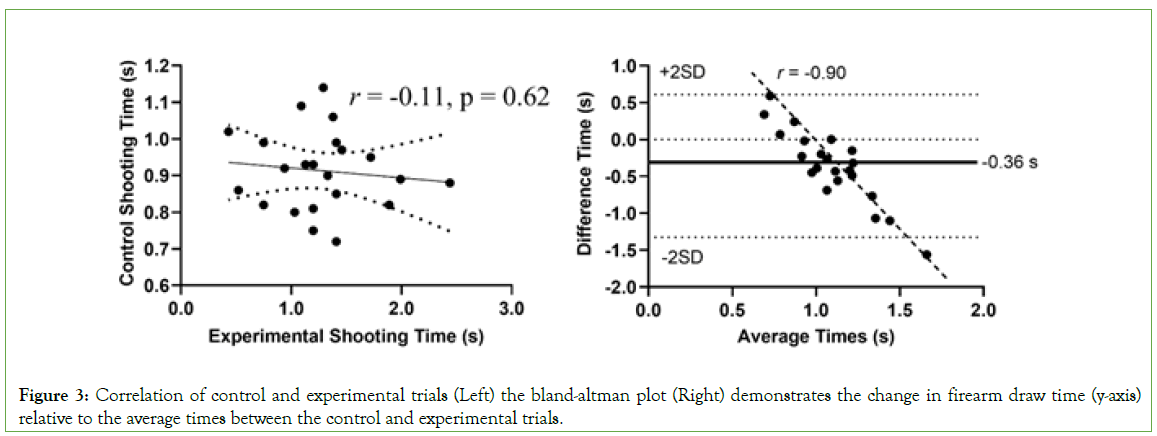
Figure 3: Correlation of control and experimental trials (Left) the bland-altman plot (Right) demonstrates the change in firearm draw time (y-axis) relative to the average times between the control and experimental trials.
On average, the first movement of the dominant arm towards the holster to retrieve their weapon occurred during the SR movement execution. As a group, the beginning of the FDP occurred -0.19 s ± 0.51 s before the complete execution of the SR movement, which for the sample was 0.59 s into the SR (i.e., 76% of the SR was completed before initiating a firearm draw response). Nine LEOs initiated the firearm response during the SR movement, seven initiated their firearm draw within one frame (0.042 s) of the completion of the SR, and four initiated after the SR movement.
When examining joint-angle-time plots in experimental and control trials, the firearm draw was fractionated into four steps: Reaching for the handgun, gripping the handgun, unholstering, and extending the elbow to shoot toward the target. However, some LEOs kept their hand resting on their holster in the experimental trial; therefore, step one and two were not executed. Figure 4 demonstrates two different methods of firearm draw that were observed in the elbow when completing the firearm draw with and without the hand resting on the holster (Figure 4).
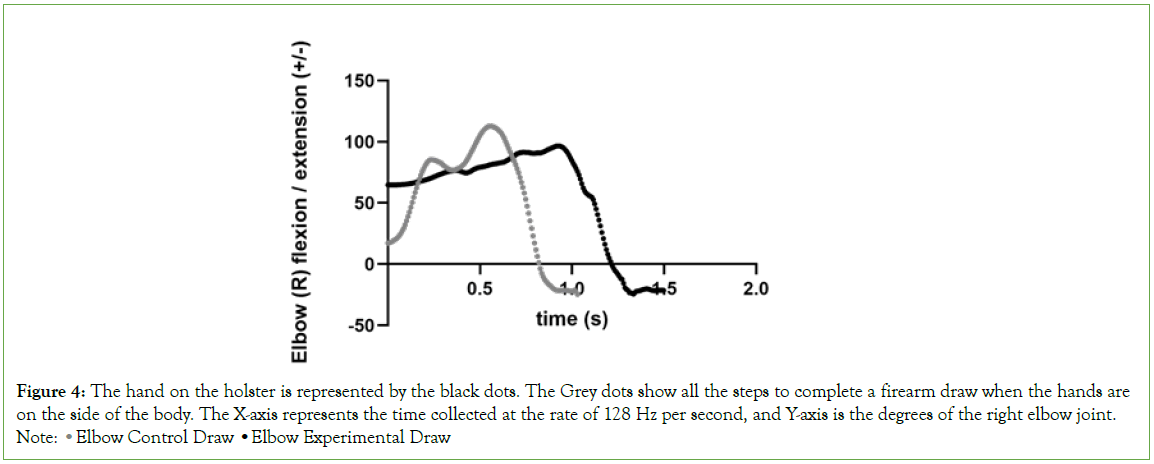
Figure 4: The hand on the holster is represented by the black dots. The Grey dots show all the steps to complete a firearm draw when the hands are on the side of the body. The X-axis represents the time collected at the rate of 128 Hz per second, and Y-axis is the degrees of the right elbow joint. Note: •Elbow Control Draw •Elbow Experimental Draw
Discussion
Neck flexion and the arm block were the most common SR observed. These findings support Lewinski, et al. observation in response to a visible lethal threat from a driver during a traffic stop scenario [6]. The shrug was only reported in two subjects, which according to Davis (1984), occurs in acoustic stimuli, such as the sound of a gunshot [10]. However, this cannot be confirmed in the current design of the present study as to whether that was the actual cause of those specific responses. In addition, the SR has been reported to act as part of the “Fight or Flight” response [13,14]. In the current study, the fight or flight response would have been caused by the male spouse beginning to shoot at the LEO. The SR was present in 20 of the 22 subjects. The current study recorded the duration of the SR and when the SR was executed concerning the firearm draw movement. The SR occurring before and during the firearm draw (a predetermined motor action) is a novel discovery. On average, 76% or 0.59 s of the SR was completed before the LEO initiated their firearm draw, placing LEOs in a situation where they are an unarmed target for up to 1.5 s. A 1.5 s duration is sufficient time for an armed threat to discharge multiple bullets at a stationary target and flee [15]. However, two subjects were observed not to experience an SR movement, possibly due to many factors. An explanation for the lack of an SR was that these subjects in the experimental trial anticipated the threat, or were able to manage the acute stress of the situation and focus on the task such as responding to the threat in the form of drawing their firearm, and preventing an SR [16]. Whereas the presence of the SR may be due to focusing on the source of the stress, such as the gunshot, attempting to protect the body, such as an arm block, then focusing on the task of returning fire. Based on the current study, involving a spontaneous firearm attack from a distance, during a home visit, it can be expected that a SR of either neck flexion or an arm block will occur that last around 0.78 s.
FDP was significantly different in the experimental trial compared to the control trial allowing us to accept the first hypothesis that there would be differences in FDP between trials. The LEOs were, on average, 0.36 s ± 0.50 s slower in the experimental trial, suggesting that when LEOs are placed in unanticipated threats of lethal force, their ability to execute similar FDP to what was achieved in a controlled environment may not be maintained. Therefore, FDP when responding to the spontaneous attack was observed to be on average 28% slower than the FDP in the control trial. However, six subjects were observed to perform their firearm draw the same or faster in the experimental trial. Similar to the SR, a consideration was that some individuals under high duress experienced more physiological control compared to other subjects during the experimental scenario. The physiological control could have been executed by managing the stress and emotions while maintaining task focus within the experimental trial. As a result, the subject’s technical skills and decision-making lead to maintaining or improving FDP. If unable to regulate these physiological and cognitive responses, task-performance decreases [17-22]. These possible physiological and cognitive changes during these scenarios may help understand why some FDPs were faster or maintained in the experimental trial compared to the control trial. Interestingly, none of the subjects who performed a faster draw time in the scenario were free of a startle response. Such a finding may indicate that the SR as a reflex may or may not impair FDP overall.
The exploratory aim did not yield significant association between FDP in the control or experimental trials and years of policing experience. More policing experience, independent of specific skill practice, was therefore not associated with FDP, regardless of the environment. These findings contradict the idea that more job experience and training would improve performance in these dynamic scenarios [1,23]. Therefore, in the current study, when examining the years of police experience, that factor may not account for the changes in FDP in the experimental trial.
Potential increases in physiological stress experienced during the current study’s scenario may support the observed slower FDP in the experimental trial. Measures of SR and FDP do not clearly explain the mechanisms that caused the decrease in performance time. However, in both cases, in the current study, subjects presented a SR and improved FDP in the experimental trial. Therefore, the documented potential physiological and cognitive responses expected during an unanticipated threat demonstrated in previous literature cannot be expected in all cases [1,24]. Our findings build upon previous literature about training motor patterns in realistic levels of occupational stress to train or better manage the psychological and physiological stressors. This is similar to athletes scrimmaging, practicing situational-based game or match scenarios to prepare the body and mind for the possible scenario and is a positive practice that police should copy [1,23,25].
The current study provided valuable information to the traditional RT paradigm (Figure 1) and the potential effect of how an unanticipated stimulus may impair motor response due to an SR. Based on the current study’s SR occurrence and duration results, a modified RT paradigm is presented (Figure 5).
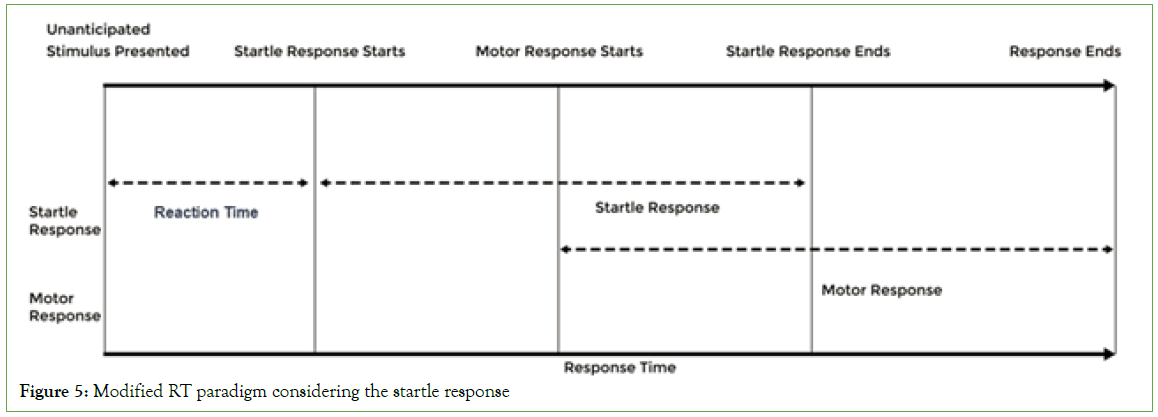
Figure 5: Modified RT paradigm considering the startle response
Limitations
The current study has multiple limitations worth discussing. The sample was from only one police department, making generalizability to all LEOs challenging. However, given that all the LEOs were fit for duty in Utah, USA, it can be speculated that states with similar fit for duty standards or demographics presented in the current study may experience equal performance outcomes. The present study evaluated a handgun assault at 6 m distance between the male spouse (i.e., threat) and the LEO during a nonthreatening home visit scenario; therefore, these results may not extend to different distances or scenarios. Lastly, the positioning of the camera in the corner of the room, away from the male spouse’s dominant side may not have provided the best representation of what the LEO was seeing or reacting to during the scenario. Therefore, future studies should consider using chest-mounted cameras, eye tracking, or strategically placing cameras throughout a scenario to view the scenario from multiple viewpoints.
Future directions
Future research should examine the modified RT paradigm to different high-stress, unanticipated stimuli. Specifically; practitioners should examine and assess the physiological, cognitive, and physical SR and how these factors influence their current expectations of motor pattern execution. With the intent of finding someway of eventually making a sr functionally useful.
Conclusion
The current study demonstrated that SR in an unanticipated stimulus of lethal force delayed response time in active-duty LEOs. Also, the neck flexion and arm block were the most common SR, and the SR took 0.78 s to execute. FDP was significantly slower in the lethal threat scenario compared to a controlled trial under no threat. The changes in FDP may have been due to the threat, the SR, or other cognitive or physiological factors not measured in the current study. However, a physical SR may place LEOs at an increased risk of being unable to protect them for an extended period. Given these findings, a modified RT paradigm explained how an SR may delay the intended motor response. LEOs are recommended to train in both controlled and dynamic scenarios to prepare their motor responses under various conditions based on the slower FDP and presence of a SR in the unanticipated lethal threat scenario in the current study.
Acknowledgment
We thank the police department, police officers, and individuals who helped organize and assist in the project.
Declarations
Conflict of interest statement
No potential conflicts of interest were reported by the author(s).
Data Availability statement
The data supporting this study’s findings are available from the corresponding author, MK, upon reasonable request.
Funding
Force Science® LTD provided financial supported for this research.
References
- Staller MS, Korner S. Commentary: Complex motor learning and police training: Applied, cognitive, and clinical perspectives. Front Psychol. 2019; 10:2444.
[Crossref] [Google Scholar] [PubMed]
- Schmidt RA, Lee TD, Winstein C, Wulf G, Zelaznik HN. Motor control and learning: A behavioral emphasis. Hum kinet. 2018.
- Tueller D. How Close is too Close? 1983.
- Sandel WL, Martaindale MH, Blair JP. A scientific examination of the 21-foot rule. Police Pract Res. 2021; 22(3):1314-1329.
- Campbell A, Roelofs A, Davey P, Straker L. Response time, pistol fire position variability, and pistol draw success rates for hip and thigh holsters. Hum factors. 2013;55(2):425-434.
[Crossref] [Google Scholar] [PubMed]
- Lewinski WJ, Dysterheft JL, Seefeldt DA, Pettitt RW. The influence of officer positioning on movement during a threatening traffic stop scenario. Law Enforc Exec Forum In-law. 2013;13(1):98-109.
- Bisdorff AR, Bronstein AM, Gresty MA. Responses in neck and facial muscles to sudden free fall and a startling auditory stimulus. Electroencephalogr. Clin Neurophysiol. 1994;93(6):409-4016.
[Crossref] [Google Scholar] [PubMed]
- Bisdorff AR, Bronstein AM, Wolsley C, Gresty MA, Davies A, Young A. EMG responses to free fall in elderly subjects and akinetic rigid patients. J Neurol Neurosurg Psychiatry. 1999;66(4):447-455.
- Hawk LW, COOK III EW. Affective modulation of tactile startle. Psychophysiology. 1997;34(1):23-31.
[Crossref] [Google Scholar] [PubMed]
- Davis M. The mammalian startle response. Neural Mechanisms of Startle Behavior.1984;287-351.
- Hou Y, Wang S, Li J, Komal S, Li K. Reliability and alidity of a wearable inertial sensor system for gait assessment in healthy young adults. Biomed Eng Informs. 2021;1-6.
- Bland JM, Altman D. Statistical methods for assessing agreement between two methods of clinical measurement. Lancet. 1986;327(8476):307-310.
- LeDoux JE, Pine DS. Using neuroscience to help understand fear and anxiety: A two-system framework. Am J Psychiatry. 2016.
[Crossref] [Google Scholar] [PubMed]
- Thayer JF, Sternberg E. Beyond heart rate variability: Vagal regulation of allostatic systems. Ann N Y Acad Sci. 2006;1088(1):361-372.
[Crossref] [Google Scholar] [PubMed]
- Kantor MA, Lewinski WJ, Garg H, Tenbrink J, Lau J, Pettitt RW. Kinematic analysis of naive shooters in common law enforcement encounters. J Forensic Biomech. 2022;13:405.
- Deutscher C, Schneemann S, Langrock R, Gehrmann S, Scholten H. Performance under pressure in skill tasks: An analysis of professional darts. PLoS One. 2020;15(2):e0228870.
- Kent S, Devonport TJ, Lane AM, Nicholls W, Friesen AP. The effects of coping interventions on ability to perform under pressure. J Sports Sci Med. 2018;17(1):40.
[Google Scholar] [PubMed]
- Stephenson MD, Schram B, Canetti EF, Orr R. Effects of Acute Stress on Psychophysiology in Armed Tactical Occupations: A Narrative Review. Int J Environ Res Public Health. 2022;19(3):1802.
[Crossref] [Google Scholar] [PubMed]
- Taverniers J, Smeets T, Van Ruysseveldt J, Syroit J, von Grumbkow J. The risk of being shot at: Stress, cortisol secretion, and their impact on memory and perceived learning during reality-based practice for armed officers. "Int J Stress Manag. 2011;18(2):113.
- Vickers JN, Lewinski W. Performing under pressure: Gaze control, decision making and shooting performance of elite and rookie police officers. Hum Mov Sci. 2012;31(1):101-117.
[Crossref] [Google Scholar] [PubMed]
- Landman A, Nieuwenhuys A, Oudejans RR. Decision-related action orientation predicts police officers' shooting performance under pressure. Anxiety Stress Coping. 2016;29(5):570-579.
[Crossref] [Google Scholar] [PubMed]
- Oudejans RR, Kuijpers W, Kooijman CC, Bakker FC. Thoughts and attention of athletes under pressure: skill-focus or performance worries?. Anxiety Stress Coping. 2011;24(1):59-73.
[Crossref] [Google Scholar] [PubMed]
- Baldwin S, Bennell C, Blaskovits B, Brown A, Jenkins B, Lawrence C, et al. A reasonable officer: Examining the relationships among stress, training, and performance in a highly realistic lethal force scenario. Front Psychol. 2022:5629.
[Crossref] [Google Scholar] [PubMed]
- Koch G, Ponzo V, Di Lorenzo F, Caltagirone C, Veniero D. Hebbian and anti-Hebbian spike-timing-dependent plasticity of human cortico-cortical connections. J Neurosci. 2013;33(23):9725-9733.
[Crossref] [Google Scholar] [PubMed]
- Anderson GS, Di Nota PM, Metz GA, Andersen JP. The impact of acute stress physiology on skilled motor performance: Implications for policing. Front Psychol. 2019;10:2501.
[Crossref] [Google Scholar] [PubMed]
Citation: Kantor M, Bartz DE, Lewinski WJ, Pettitt RW (2023) Startle Response and Firearm Draw Performance in Law Enforcement Officers during a Lethal Force Simulated Domestic Assault. J Forensic Biomech. 14:430.
Copyright: © 2023 Kantor M, et al. This is an open access article distributed under the terms of the Creative Commons Attribution License, which permits unrestricted use, distribution, and reproduction in any medium, provided the original author and source are credited.
